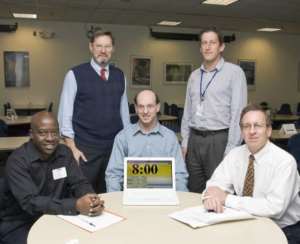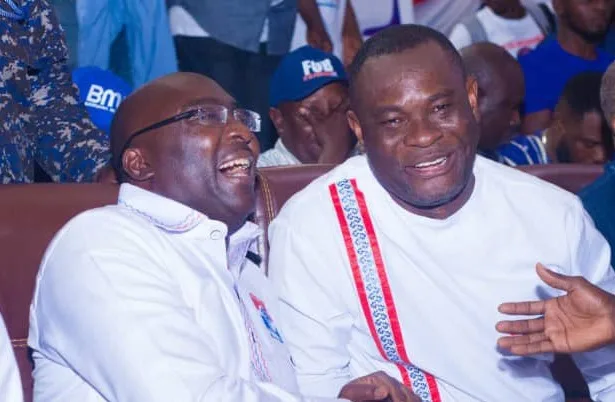
Licensee Kreative Waves Markets Globally
Photo: Elle Starkman, PPPL
 The Academic Competition Software team includes, from left, licensee Kwame Andah, PPPL Tech Transfer Head Lewis Meixler, PPPL computational scientist Eliot Feibush, PPPL Science Education Head Andrew Zwicker, and Princeton University's Bill Gowen. Gowen is from the Office of Technology Licensing and Intellectual Property. Not shown is PPPL's James Morgan, one of the ACS inventors.
The Academic Competition Software team includes, from left, licensee Kwame Andah, PPPL Tech Transfer Head Lewis Meixler, PPPL computational scientist Eliot Feibush, PPPL Science Education Head Andrew Zwicker, and Princeton University's Bill Gowen. Gowen is from the Office of Technology Licensing and Intellectual Property. Not shown is PPPL's James Morgan, one of the ACS inventors.
by Patti Wieser
[email protected]
By trimming trips around the Lab, an invention from the U.S. Department of Energy's Princeton Plasma Physics Laboratory (PPPL) may make its way around the globe.
"I was tired of running to various locations on site to collect pieces of paper with scores from Science Bowl® rounds," says James Morgan, PPPL Science Bowl® coordinator. At the time, bowl organizers used a combination of timer clocks, entries on paper, and individual computers to consolidate individual entries.
In response, a team at PPPL developed unique software for real time scoring and tracking of academic competition games. Basically, it combines and computerizes timekeeping and scorekeeping functions for academic competitions. Morgan and Science Education Head Andrew Zwicker mapped out what they wanted and computational scientist Eliot Feibush and summer intern Ben Phillips developed the software code.
In 2009, the team filed an invention disclosure for the Academic Competition Software (ACS). The ACS combines digital clocks and a scoring system that permits different point values for different types of questions. A sub-timer system monitors bonus or toss-up questions. All data is consolidated on the fly and a single person can operate the system. Results from different sites or rooms can be added in as well.
Feibush said, "The players, coaches, audience, and officials all benefit from the enhanced display. Teams can practice with it in advance to learn the rules."
Science Bowl® volunteers used ACS during the 2009 and 2010 regional Science Bowls at PPPL. Now with a copyright, an invention disclosure and a licensee, the software is being marketed as ScoreBit across the world. "We were a little nervous during the first-time use, but it was awesome," Morgan recalls of the 2009 bowl. "I love it. It's great. It has the potential to change the face of academic competitions."
Shortly after the invention disclosure, entrepreneur and IT professional Kwame Andah learned about the software while chatting with PPPL Technology Transfer Head Lewis Meixler, who gave Andah the abstract and set up a demonstration. "Oh my goodness, this is really, really cool," Andah recalls of his initial reaction.
Photo: Elle Starkman, PPPL
 The software in use at a Science Bowl® hosted by PPPL.
The software in use at a Science Bowl® hosted by PPPL.
Andah established the Delaware-based "Kreative Waves" and negotiated the licensing for commercial use. While the federal government can use the software free worldwide, Kreative Waves may license it to others through a non-exclusive worldwide license.
Meixler and William H. Gowen at Princeton University's Office of Technology Licensing and Intellectual Property worked on the licensing agreement. "We had been looking for someone to license the software. Kwame grasped the potential of it immediately," Meixler says.
Andah envisions a long and broad future for the software, and believes it will stimulate more academic competitions and encourage educational activities, with potential beyond academic functions. "Along with Science Bowls and Science Olympiads, it could help students prepare for college debates, especially with the time issue, and any competition. We could even tweak it for sporting events, using the clock and scoring combined features. There are a number of avenues and a wide range of ways this software can work," he says.
The software is presently in the marketing phase. Andah, the son of parents in the diplomatic corps, is marketing it in his native Ghana, among other locations. He says he was drawn to the software's potential because there were academic competitions regularly at boarding schools he attended in Ghana, Ivory Coast, UK, France, and Malta.
"We are helping students be challenged and prepared," Andah says. "We'd also like to turn this product into an Internet product so it could be used in distance education. One year from today I envision this product being used by people in Canada, the U.S., and Africa, and being a staple in education."
For now, it is being used at some Science Bowl® competitions in the U.S. And the accolades are rolling in. One high school science department chairman from Florida, whose school used the software earlier this year, says, "The score keeping software was magnificent. The regional coordinator told me that Princeton Plasma Physics Laboratory provided the software. Is this software available for use by local NSB [National Science Bowl®] participants?"
Originating at www.pppl.gov




 List of 24 ministerial nominees approved by Parliament
List of 24 ministerial nominees approved by Parliament
 You were my inspiration, made me who I am today – Lilian Kumah
You were my inspiration, made me who I am today – Lilian Kumah
 Rainstorm destroys Hohoe E.P. Senior High School building
Rainstorm destroys Hohoe E.P. Senior High School building
 John Kumah strongly supported me to become NPP flagbearer – Bawumia reveals
John Kumah strongly supported me to become NPP flagbearer – Bawumia reveals
 Late John Kumah urged me to run for NPP flagbearer, strongly supported me — Bawu...
Late John Kumah urged me to run for NPP flagbearer, strongly supported me — Bawu...
 Akufo-Addo appoints Joseph Kpemka as Deputy MD of BOST
Akufo-Addo appoints Joseph Kpemka as Deputy MD of BOST
 Ablakwa petitions CHRAJ to investigate sale of SSNIT's hotels to Rock City Hotel
Ablakwa petitions CHRAJ to investigate sale of SSNIT's hotels to Rock City Hotel
 MoF to provide new bailout for defunct Gold Coast Fund investors – Bawumia revea...
MoF to provide new bailout for defunct Gold Coast Fund investors – Bawumia revea...
 OMCs implement price adjustments despite International petroleum price declines
OMCs implement price adjustments despite International petroleum price declines
 Petition to remove Kissi Agyebeng will disrupt operations of OSP – Martin Kpebu
Petition to remove Kissi Agyebeng will disrupt operations of OSP – Martin Kpebu
